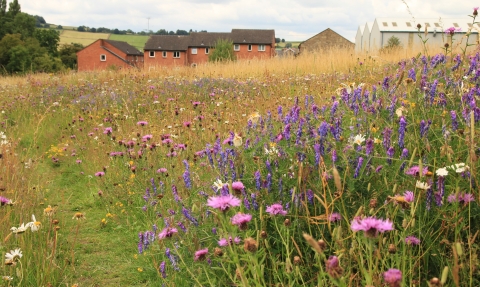
Meadows and houses by Kieron Huston
Responding to planning applications and consultations
Responding to planning applications and consultations gives wildlife a voice in the planning system.
Find out more about what BBOWT does to give wildlife a voice in the planning system, and what you can do to help make sure developers and local authorities are adhering to policies when they plan new buildings and developments.
What BBOWT does
We give wildlife a voice by:
- responding to strategic planning consultations, such as Local Plans, ensuring appropriate policies are in place
- campaigning to ensure that the protection of wildlife is integral to the policies of all planning documents
- commenting on selected planning applications where there is potential for significant impact on wildlife, or where there is opportunity to make significant gains for wildlife
- providing advice to, and / or consulting with, local planning authorities, developers and their consultants, other NGOs and statutory agencies
- providing advice to members of the public
We respond to a selection of key planning applications and policy documents. We do not have the resources to respond to each and every planning application that may affect wildlife in the three counties. We have adopted a strategic approach to allow efficient use of limited resources.
We prioritise applications that impact on designated sites or the Trust’s nature reserves, or where there will be the most significant positive or negative effects on wildlife, such as selected large applications involving hundreds or thousands of homes, large-scale infrastructure/development projects, and Local Plans.
We also work in partnership with other national and local organisations in the three counties to develop strategies and systems that help in making the case for wildlife in planning.
What you can do
We get many requests for help in writing and commenting on planning applications. We do not have the resources to respond to every planning application individually but we recognise that there are many planning applications that will affect wildlife. We encourage individuals or community groups who want to stand up for wildlife in their areas to take part in consultations and provide these tips for how to respond to a planning application.
Top ten tips for responding to planning applications
- Make sure you read through the plans and documents so you have a clear view of what the development entails and what the impacts may be. Plans and documents are made available for public viewing on your local council's website. If you would like more information or feel that key information is missing, you can contact the case officer for the application.
- Consider what impacts the proposed development may have on wildlife. Read through any ecological surveys that have been submitted with the application, and refer to them in your comments. If no surveys have been done, but you think they should have been, state this in your comment. You may like to make reference to Natural England's Standing Advice on Protected Species. You can also find useful information on relevant documents and contacts here.
- Follow your council's instructions for submitting comments. Normally you can submit your comments online through your council's planning portal, or by email or letter to the case officer or to the planning department. Include the application reference number in the subject line or heading.
- Present your concerns in a formal, polite and effective manner.
- Make your letter concise and communicate your concerns clearly.
- Clearly relate your comments to Local Plan policy, national planning policy or other legislation. Case officers will only consider matters that are 'material considerations' in the planning system, which basically means they must be covered by legislation or planning policy. You can have a look at our useful guide to relevant planning policy.
- Where relevant, remind the local authority of wildlife legislation, national biodiversity policy and the local Biodiversity Action Plan and Biodiversity Opportunity Areas or Conservation Target Areas.
- Be realistic and constructive in your comments - for example, suggesting alternative locations or design solutions that would address your concerns.
- Keep in mind that the local authority may decide that overall the benefits of a proposal outweigh any possible harm. Consider and suggest to the case officer that conditions are applied to ensure sufficient and suitable biodiversity mitigation and enhancement if the development is granted permission so that a net gain in biodiversity is achieved.
- Remember, your view is important and your local authority has a duty to listen.
Find out more about planning and wildlife in our area
- How to help wildlife where you live (https://www.bbowt.org.uk/planning-how-help-wildlife-where-you-live)
- Planning policy and the planning system (https://www.bbowt.org.uk/planning-policy-and-planning-system-england-and-wales)
- Development and wildlife (https://www.bbowt.org.uk/development-and-wildlife)
- Wildlife and the law (https://www.bbowt.org.uk/wildlife-and-law)
- Useful contacts and information (https://www.bbowt.org.uk/planning-and-development-useful-information)
